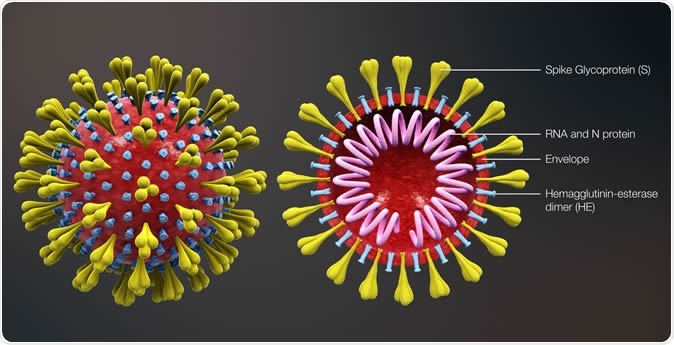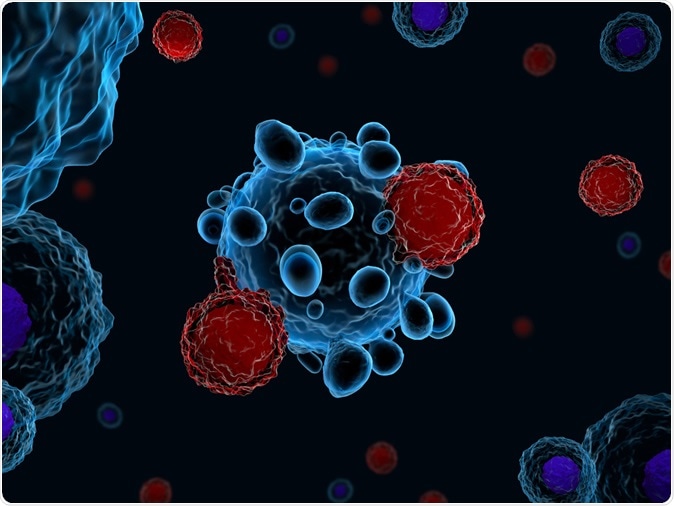Many different T cell receptors recognize SARS-CoV-2 antigenic sites
by Dr. Liji Thomas, MDThe global COVID-19 pandemic caused by severe acute respiratory syndrome coronavirus 2 (SARS-CoV-2) is spreading over the world. However, not much is known about how the adaptive immune response kicks in following the viral challenge. This knowledge is crucial to predicting the efficacy of a vaccine and estimating the chances of reinfection.
Now, in new research published on the preprint server medRxiv*, Russian scientists aimed to understand the determinants of adaptive immune response to SARS-CoV-2. To do this, they assayed both antibody and T-cell reactivity to SARS-CoV-2 antigens in COVID-19 convalescent patients and healthy donors sampled before and during the pandemic.
The Importance of Antibody Tests
Based on current knowledge, it is thought that viral clearance occurs because of an antibody response. A variety of antibody tests are therefore being developed to detect specific antibodies directed against the virus and to use such tests for immunological surveillance to estimate the seroprevalence of COVID-19.
Another important application would be the development and use of monoclonal antibodies and convalescent plasma to treat severely ill COVID-19 patients. Monoclonal antibodies against the Spike protein have been found to neutralize SARS-CoV-2 even when inoculated at high doses into experimental animals
On the other hand, almost a third of convalescent patients show negligibly low levels of such neutralizing antibodies, which could mean other immune components are also necessary to clear the virus from the host by immune mechanisms.
The Potential Role of T Cells in Viral Clearance
T cells are strongly implicated in the respiratory clearance of the earlier SARS-CoV, with long-lived memory T cells being observed to be present in 50% of convalescent patients even 12 months after infection.
Another study showed the presence of CD8 cells targeting the dominant antigenic site of the S protein of a modified SARS-CoV strain, and that these cells prevented fatal infection in old mice. Other researchers have demonstrated that immunity can be transferred via specifically-primed CD8 or CD4 cells, or by the use of a peptide-pulsed dendritic vaccine.

Coronavirus https://www.scientificanimations.com / CC BY-SA (https://creativecommons.org/licenses/by-sa/4.0)
These suggest the adequacy of T cells to clear the virus even without antibody production or activation of the innate immune system. The CD4 cells may lead in this response, with low CD4 levels causing slower viral clearance, but not low CD8 levels. When CD4 cell responses were satisfactory, the SARS infection generally had a good outcome.
Human T Cells Response to COVID-19
In human studies, the adaptive immune response is slow to develop in the case of severe SARS-CoV, and virus clearance is delayed. Low T cell counts are associated with more severe disease. T cells also help form a memory response. Thus, even four years later, these patients had CD4 and CD8 cells that secreted the inflammatory chemical interferon-gamma when stimulated by pools of peptides from the S, N, and M proteins of the virus.
Among all the SARS-CoV antigens, the S protein stimulates the highest level of antibody production. The epitopes of this protein that bound to CD4 and CD8 T cells were identified. Two of these epitopes binding to CD8 cells were presented by the MHC II molecule HAL-A*02:01 and stimulated a specific response in patients who had recovered from SARS but not healthy individuals. Many other T cell epitopes in the M and N proteins of the virus have also been identified.
T Cells in COVID-19
There is now much evidence that the T cell response is crucial to controlling COVID-19. Elevated CD8 T cell counts in the lungs predict a favorable disease course. Again, the presence of T follicular helper cells and activated CD8 T cells in the blood of recovering patients with negative PCR tests, indicating viral clearance, shows their possible role in the immune response. If the CD8 cells are exhausted, on the other hand, the outcome of the disease may be poor.
It is thought that the immune memory cells can protect against reinfections with SARS-CoV-2, based on primate studies. The T cells in recovering patients react to stimulation by the pools of peptides from the viral proteins. This was especially true of the Th1 response in CD4 cells, induced by the S protein of this virus.
An interesting finding was the reactivity of CD4 cells to SARS-CoV-2, both in recovering and in healthy individuals. The scientists attribute this to “T cell cross-reactivity.” In the absence of experimental data on the T cell targets, the current study aims to understand the immune response to the virus; to identify the structure, clonal nature, and specific epitopes of the T cell-mediated immune cellular response to the S protein.
SARS-CoV-1-Specific T Cells in Healthy Uninfected Donors
The researchers found that there were specific T cells but not antibodies in healthy blood donors from whom samples were taken during the pandemic. This probably rules out the chances of past asymptomatic COVID-19 in this group. Both CD4 and CD8 T-cells specific for S-protein were found in this group. This could mean some patients were exposed to the infection but did not develop overt symptoms.

Illustration of immune system T cells attacking cancer cells. Image Credit: Meletios Verras / Shutterstock
In the convalescent patient group, there were T cells directed against the S protein. The CD4 cells were mostly memory cells and a few effector cells, while the CD8 cells were mostly effector cells. However, the number of activated CD4 cells was significantly greater, as was the level of PD-1 expression by interferon-secreting CD4 cells, in the convalescent patient group compared to the healthy donors.
Most of the IgG antibodies in convalescent COVID-19 patients were directed against one or more of the viral antigens. Nonetheless, there were antibodies against all three antigens, S. N and M. The T cell response varied, with no clear relationship between the T cell and humoral response.
T cells in this group reacted to the recombinant S protein but not to peptide pools derived from the S protein, with equal responses in CD4 and CD8 cells. All the patient serum samples reacted to one or more of the viral proteins, M or N, with either CD4 or CD8 responses.
Immune Response to Two Epitopes Detects Past COVID-19
Among the 31 convalescent serum samples, there were 14 with a common MHC allele. Just two of 13 epitopes (called RLQ and YLQ), reported to be presented by this MHC molecule and to induce a robust immune response, were recognized by T cells, in 12/14 and 10/14 samples. They were not recognized by samples from healthy donors, showing that these cells came from the memory cell population.
Based on T cell receptor (TCR) analysis, these cells belonged to a large number of antigen-specific clones, with a median of 115 CD4 and 18 CD8 cell clones. There were markedly more clones of cells recognizing one of the two epitopes above than the other (median 37 vs. 8). Hardly any clones recognized both the epitopes, suggesting these clones may be localized to the peripheral tissue rather than the peripheral circulation.
TCR Sequence Motifs Prominent and Shared Across Individuals
Some variable genes are used far more frequently by the TCRs for these two epitopes compared to the control TCRs. There is also a set of three distinct motifs from the CDR3 alpha and beta chains, respectively, each containing over ten very similar sequences from the epitope-specific T cells. All these motifs were found in most of the donors but without any pairing pattern between the motifs of different chains. This suggests this is a public response even while being diverse.
Finally, the TCR repertoire analysis showed that there were groups of homologous TCR sequences that arose from an antigen-specific response. This showed 9 CD4 and 8 CD8 clusters shared between stimulated T cells from multiple healthy donors. One of these has matching TCR sequences with those found in T cells specific to one of the two epitopes above and is also present in peripheral blood mononuclear cells (PBMCs). Thus, this set of sequences is shared by both the interferon-producing CD8 cells and the PBMCs.
What Does This Study Show About COVID-19 Seropositivity?
The researchers draw the following conclusions:
Some healthy uninfected donors carry SARS-CoV-2-specific T cells, and these are increased in donors sampled during the pandemic, though there are no antibodies. This indicates that some donors could have been exposed to the virus, but the cross-reactive antibodies against other CoVs protected them from the full infection.
The study helps outline the cellular immune response to COVID-19. More research will be needed to fill in the gaps, helping evaluate and develop a potent vaccine against this virus.
Important Notice
medRxiv publishes preliminary scientific reports that are not peer-reviewed and, therefore, should not be regarded as conclusive, guide clinical practice/health-related behavior, or treated as established information.
Journal reference:
- Shomuradova, A. S., et al. (2020). SARS-CoV-2 epitopes are recognized by a public and diverse repertoire of human T-cell receptors. medRxiv preprint doi: https://doi.org/10.1101/2020.05.20.20107813.